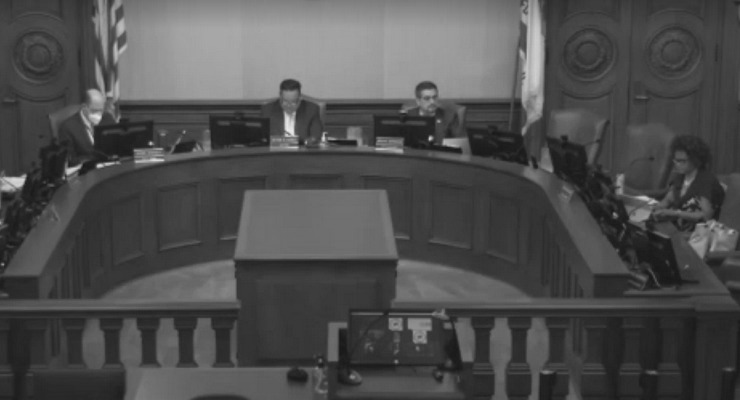
Earlier this month, Sen. Anthony Portantino (D–Pasadena) joined several other state senators in submitting a formal request to the Joint Legislative Audit Committee to approve and authorize an audit to examine the Department of Housing and Community Development’s (HCD) regional housing needs determination process.
“We’re facing an unprecedented housing crisis and transparency is critical to determining regional housing needs,” Portantino said. “I join my colleagues in requesting a state audit in order to determine how our housing needs are being calculated and if they are being assessed appropriately. Several cities in the 25th Senate District have expressed concerns over regional housing allocations, and I hope this audit will help address those concerns.”
Currently, HCD is responsible for determining the regional housing needs assessment (RHNA) for each region’s planning body.
Last year, RHNA mandated Pasadena ensure the building of 9,408 units of new housing by October 2029, including 2,740 units of very low-income housing, 1,659 of low-income housing, 1,562 moderate-income housing, and 3,447 units of above-moderate income housing.
City and elected officials have called the task “impossible.”
“Like other cities in the region, Pasadena has housing challenges that we are actively working to address,” said Mayor Victor Gordo. “A review of the RHNA allocations set forth by HCD is desperately needed in order to ensure cities like ours, that are doing their part to address housing needs, are not treated unfairly. Moreover, because the current RHNA allocations are unrealistic, achieving them will be impossible. This approach helps no one. Let’s work on realistic goals and work together to achieve them.”
The city unsuccessfully attempted to appeal the allocation.
The audit’s scope will assess the state Department of Finance’s process for developing population projections used by HCD and determine what changes the department made to its projections in response to economic and demographic changes caused by the pandemic as well as new census information.
The audit will also evaluate the historical accuracy of the finance department’s population projections and HCD’s process for developing regional housing needs determinations to verify that it complies with state law and results in appropriate calculations.
HCD uses a formula to calculate the needs for each region, starting with demographic population information from the Department of Finance. This figure is negotiated with each council of governments to arrive at a final assessment.
This process does not allow the public to receive any information on the formula that HCD uses to calculate these initial numbers, which creates confusion and mistrust among the regional planning bodies and cities, according to Portantino.
“An audit by the California State Auditor will provide independently developed and verified information related to the Department of Finance, and the Department of Housing and Community Development’s role in calculating housing needs, the regional governments’ roles in allocating housing needs, and local jurisdictions’ roles in accommodating housing needs to facilitate development,” Portantino said in the statement.



















One thought on “Portantino Requests State Audit on Formula Used For Regional Housing Need Allocation”
Here is my simplified however supported analysis of the housing problem. Hope it helps your understanding of the legislative debacle. We used this in zoom meetings with both Senator Allen and Assmblymember Muratsuchi. Population growth has now been reported as negative since I wrote this
4/27/2021
Thank you Senator Allen for meeting with us today. I will provide some population growth perspective on why the current raft of housing bills are unnecessary. I have found this information in a May 1, 2020 report by the California Department of Finance (1) and also from Dept. of Housing and Community Development (2) and SCAG (3). I also use a current report from the Public Policy Institute (4).
In 2019 California’s population grew by only 0.2 percent, continuing an historically slow growth trend since the Great Recession. 0.2% equates to an increase of 80,000 people per year. According to the charts, the population growth rate has been declining consistently since 1991 and there is no indication that the growth rate will increase. The current growth estimate is now between .05% and .06%. It has fallen dramatically since May 2020.
Los Angeles County, the state’s most populous county, has now lost population the last two years, dropping 0.3 percent in 2018 and 0.1 percent in 2019. Torrance, Redondo, Hermosa, Manhattan, Carson all lost population.
2019 is the first time the state has added more housing units than people. We are now building more housing than we need. Continuing an 8 year trend, we are now building more apartments than single family homes by about 8600 units. California continues to add housing faster than we are growing. The wrong types of housing may be getting built. The market is looking for single family homes judging from the rapid increase in pricing.
In looking at Housing and Community Development RHNA calculations, HCD is projecting a need for over 1.3 million housing units by October 2029 ONLY in the SCAG region. Further, SCAG has objected (3) to this large number and countered with a total need of 800-900,000. Juxtapose both of these estimates with a constant 0.2% population growth driven need for housing of approximately 400-600,000 units for the entire state over this period.
Now using the NEW high side growth estimate of .06%, growth is only 24,000 a year for the entire state. Extrapolating that out to the end of the RHNA cycle in 2031 that is a total statewide increase over the next 10 years of only 240,000 new residents. Using census data of 2.93 residents per dwelling in California, we only need 81,911 housing units over the next 10 years. That’s only 8,191 per year for the entire state!
And the questions arise, “Why is the legislature creating all of these housing bills?” and “Why have the RHNA estimates not been reduced to match the data?”.
Thank you for your time and please consider a NO vote on the housing measures.
If you like I can provide a pdf copy of this write up which includes links to the reports.
1) http://www.dof.ca.gov/Forecasting/Demographics/Estimates/e-1/documents/E-1_2020PressRelease.pdf
2) https://www.hcd.ca.gov/community-development/housing-element/docs/southern_california_association_of_governments_regional_housing_need_determination_for_the_sixth_housing_element_update_1.pdf
3) https://scag.ca.gov/sites/main/files/file-attachments/scag-objection-letter-rhna-regional-determination.pdf?1602190274
4) https://www.ppic.org/publication/californias-population/#:~:text=According%20to%20estimates%20by%20the,halt%20(0.05%25%20gain).